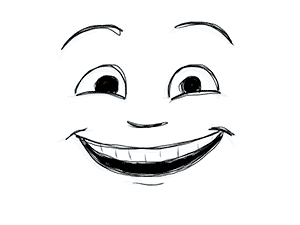The Exquisite Face.
by
Every so often I decide to retire an iAnimate lecture or two, just to keep things fresh. This article is a summary of one such topic that has become one of my favorites. I’m sure I’ll keep the subject alive, just in a new way.
Find the Recipe.
I’ve discovered something new while trying to explain or analyze emotional beats in front of recent classes: at whatever moment you try to determine a person’s emotional state (or your character’s) it will never be made of just one single feeling.
I know that sound obvious, but let me explain…
My animation technique employs the concept of “attitudes” as its foundation – the ability to identify the succession of broad emotional changes that you can express in very few, if not single words (and poses.) In practice, however (at least on-the-spot in front of a virtual classroom of animators,) it is really difficult to nail down a single-word emotion at any point in an actor’s performance, or a person’s behavior. Yes, for the sake of brevity, you can use one generic word to help put a label on it and keep you organized; but the complex and nuanced recipe that makes up any one “attitude” is really different for any one person at any one moment. If you don’t take the time to uncover those layers, I think, you start depending on your creative bag of tricks, or cliché expressions that have lost their potency over time. Both of these things are creatively stifling, and I am trying my best to make more room for this analysis in both my student reviews and my own personal work.
That’s not to say that I’ve never looked this deep in to the soul of a performance before. Rather, it’s always been a subconscious act that I need to turn in to a more conscious exercise, for both myself and my students.
So, what do I mean when I refer to these expression combinations, or recipes? Really, something as simple as a math equation that expresses how the smaller, more nuanced emotions add up (or even multiply) to create the more broad emotional state. Happy = love + joy. Anticipation = fear + excitement. Satisfaction = pleasure + comfort + security, or many other potential combinations.
The trick to finding the most effective facial expression is knowing (or simply making up) what that combination of emotions and conditions are, and then finding the unique recipe that makes that emotion look unique, complex, interesting and engaging – one that inspires your audience’s imagination, memory and empathy in the strongest possible way.
My Surreal (and pretentious) Title.
The title of this article comes from a game popularized by the Surrealists in the early 20th century – called “The Exquisite Corpse.” Most of us have probably played it as children, but the game’s derivatives have remained quite popular with certain nerdy/creative sets. The basic gist is: a piece of paper, folded in thirds, on which a participant begins a drawing (usually the head of a person or some other creature) and then passes the paper on to the next participant to complete the next third of the drawing (probably the torso) without being able to see the previous artist’s sketch, except for the few lines that will connect it to their own. The resulting drawings are always weird and entertaining, but often create something surprisingly inspiring and explainable. – that is: the imagination can use these familiar parts, put together in unusual combinations, and create a brand new narrative.
I believe the hemispheres of the face (the top and the bottom) can be used in the same way to create unusual but believable facial expressions, ones that can create equally new and interesting narratives of their own.
All of us are dummies, really…
A great example, I think, is this very silly and unintentionally insightful performance technique used by the ventriloquist Nina Conti.
What I love about this video can be encapsulated in sort of a 3-layer analysis. 1) We can clearly see the “victim’s” true emotions through his body language and eye expression. 2) The mask he is wearing has no ability to change its expression, and yet we read the feeling it is supposed to be expressing, and 3) the combination of the two incongruent expressions create something relatively new, probably unexpected, and thus totally funny. It creates the illusion of an emotion greater than the sum of its parts.
With this idea in mind, I would encourage any new animator who’s feeling stuck in a rut, and feels unable to come up with what they feel are strong and interesting facial expressions, that they try to play a game of their own – “The Exquisite Face.” By combining normally incongruent “tops” and “bottoms” on a face (typically some certain eye expression with a seemingly unrelated mouth expression) you can potentially create a very readable emotion that you didn’t expect to see. Usually, this new expression has many more layers to it than your typical boilerplate “happy”, “sad” or “angry” face. It can definitely be greater than the sum of its parts!
But this is not only a way to amuse yourself, it can also stretch your perceptions of how we use our faces, and expose you to new combinations of believable shapes that you can add to your arsenal. It can make it less likely that you run out of ideas, and, more importantly, help you notice more nuance in the facial expressions of real people that we all should be depending on as our points of reference.
Some Common Questions.
Can this idea also be used with the left and right sides of the face?
Sometimes, but it’s not very common – at least emotionally. Yes, we can (and do) sometimes express out of one side of our mouth, or one side of the eye mask. But, this is usually a specific character quirk, or a graphic choice used in order to look appealing on camera.
How far can I push the mouth or the eyes to be different from the other?
There are are very few limits, but I always stress that it is important to adhere to proper facial anatomy, especially if you are going to put together unusual combinations. Successful facial expressions create empathy; the ability of the viewer to “feel” what the character is feeling. When it comes to the face, this actually involves a slight bit of imitation on the part of the viewer. We actually contract our facial muscles in an almost imperceptible imitation of the person we are attempting to empathize with. This subtle mimicry is said to release chemicals to our brain that help us “feel” the emotion we are viewing. So, if that is the case, if we can’t quite understand what muscles are being used (or you are simulating muscles that don’t even exist) then your audience won’t be able to figure out what emotion they are watching at that moment. They won’t be able to “feel” it.
By the way, here’s a great example of some seriously pushed facial muscles. (sorry, this one just makes me laugh.) 😉
Not A Science, Just An Exercise.
While I don’t really offer any of this as a tried, true or traditionally practiced method, it has been surprisingly helpful. I know it is a cliché to say “we are constantly learning” as animators, but, hell, we are. So, I may be retiring this lecture, but I’m only beginning the use of this new tool. I’ll keep you posted as to how it goes, you can be sure!
/ken





That’s a very nice topic. Thanks 🙂
Thanks a lot Ken! That actually makes a lot of sense!
There are times I find myself playing with my thumbnails or with my character in Maya, looking for the way to push the expressions further , going from good to great. But sometimes I’m not quite sure what I’m searching for until I accidentally get it. Sure this technique will help me to find more genuine expressions since the beginning ;).
Looking forward to your next post!!